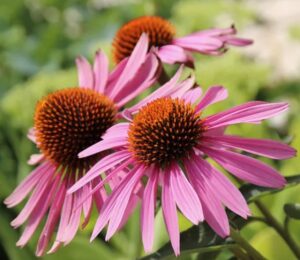April plant of the month: purple coneflower
Submitted by the Bath Gamma Garden Club
Echinacea, or Purple Coneflower, is possibly one of the most well know prairie flowers. “Echinos” is Greek for hedgehog. The prickly scales in its large conical seed heads resemble the spines of an angry hedgehog. The showy 2-inch-wide daisy-like flowers with droopy lavender petals and a bronze center cone are native to North America (zones 3-8). They bloom profusely for up to two months in mid to late summer and can re-bloom in fall. Average height is 24-36 inches. They are long lasting as cut flowers.
Purple Coneflowers are classified as an Herbaceous Perennial and are effective in borders, naturalized areas, prairies, wildflower meadows and open woods. They attract butterflies, hummingbirds, beneficial insects, and provide nectar for moths. When left to dry on the erect stems, the seed heads attract goldfinches and other songbirds.
Purple Coneflowers grow best in fertile loamy soil with medium moisture and full sun but will adapt to moderate shade, dry soil, heat and humidity once established.
To propagate, sow seeds directly in the soil in late fall. They can also be stored, stratified and planted in spring. Cold, moist stratification for two months improves germination. You can also propagate by root division in early spring. However, this method seems to produce less flowering. Young plants for transplanting are readily available in spring.
Echinacea is known around the world for its medicinal properties to treat various diseases. Archaeologists have found evidence that Native Americans used echinacea for more than 400 years to treat infections and wounds. Although use of the popular herb peaked in the 18th and 19th centuries, popularity declined in the U.S. after the introduction of antibiotics. Most scientific research on echinacea has been conducted in Germany.
Today, herbal supplements, tinctures and teas containing echinacea have customarily been used as a treatment for the common cold, cough, bronchitis, upper respiratory infections and some inflammatory conditions. It is believed to have a natural antibiotic property. Clinical trials vary and are inconclusive. Take herbal medicine and supplements under the guidance of a knowledgeable health care provider.
Enjoy the beauty of echinacea blooming in your landscape and the pollinators that they will attract. Black-eyed Susan, Asclepias (butterfly weed), Bee Balm and Goldenrod are a few of the great companion plants for your native garden.
Sometimes the most prolific stand of native Purple Coneflowers are planted by the birds and Mother Nature. Cheers to effortless gardening. For more information, contact bathgammagardenclub@gmail.com or visit gardenclubbathohio.org. ∞

